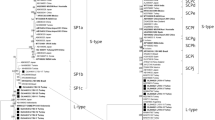Abstract
Phylogenetic analysis and estimation of the rate of evolution of West Nile virus (WNV) were conducted. Sixty-eight nucleotide sequences of WNV E protein were used for the analysis. The rate of nucleotide substitution accumulation was 2.5 × 10−4 substitutions per site per year. Phylogenetic analysis and estimation of WNV evolution time using molecular-clock methodology demonstrated that the WNV genotypes 1, 2, and 4 with an estimated time of divergence from the common precursor of approximately 2360, 2800, and 5950 years, respectively, circulate on the territory of the European part of Russia. The ratio of frequencies of nonsynonymous substitutions (dN) to synonymous substitutions (dS) can vary within 0.022–0.275 for certain WNV strains grouped according to geographical and/or phylogenetic traits. The highest values of dN/dS ratio were found for modern WNV isolates in Russia and in North America, which appeared in new natural biocenoses of these regions in the last 14 years. dN/dS estimation for WNV species shows that indices of intraspecific dN/dS variability can be used for detecting the presence of accelerated evolution of new WNV isolates. All this confirms the hypothesis that favorable conditions exist for wide distribution and rapid evolution of different WNV genotypes (that arose 2000–6000 years ago) in modern natural and climatic conditions.
Similar content being viewed by others
References
Glushkova, L.I., Korabel’nikov, I.V., Egorova, Yu.I., et al., Dezinfekts. Delo, 2012, vol. 1, pp. 52–56.
Platonov, A.E., Karan’, L.S., Shopenskaya, T.A., et al., Zh. Mikrobiol. Epidemiol. Immunobiol., 2011, vol. 2, pp. 29–37.
Subbotina, E.L. and Loktev, V.B., Mol. Biol., 2012, vol. 46, pp. 82–92.
Ternovoi, V.A., Shchelkanov, M.Yu., Shestopalov, A.M., et al., Vopr. Virusol., 2004, vol. 49, pp. 52–56.
Ternovoi, V.A., Protopopova, E.V., Surmach, S.G., et al., Mol. Genet. Mikrobiol. Virusol., 2006, vol. 4, pp. 30–35.
Shopenskaya, T.A., Fedornova, M.V., Karan’, L.S., et al., Epidemiol. Infekts. Bolezni, 2008, vol. 5, pp. 38–45.
Alley, R.B., Fahnestock, M., and Joughin, I., Science, 2008, vol. 322, no. 5904, pp. 1061–1062.
Bondre, V.P., Jadi, R.S., Mishra, A.C., et al., J. Gen. Virol., 2007, vol. 88, no. 3, pp. 875–884.
Brugger, K. and Rubel, F., Prev. Vet. Med., 2009, vol. 88, pp. 24–31.
Bryant, J.E., Holmes, E.C., and Barrett, A.D., PLoS Pathog., 2007, vol. 3, p. e75.
Campbell, G.L., Marfin, A.A., Lanciottl, R.S., and Gubler, D.J., Lancet. Infect. Dis., 2002, vol. 2, pp. 519–529.
Drummond, A.J. and Rambaut, A., BMC Evol. Biol., 2007, vol. 7, p. 214.
Gaunt, M.W., Sall, A.A., de Lamballorie, X., et al., J. Gen. Virol., 2001, vol. 82, no. 8, pp. 1867–1876.
Gubler, D.J., Clin. Infect. Dis., 2007, vol. 45, pp. 1039–1046.
Hayes, E.B., Sejvar, J.J., Zaki, S.R., et al., Emerg. Infect. Dis., 2005, vol. 11, pp. 1174–1179.
Kaufman, D.S., Schneider, D.P., McKay, N.P., et al., Science, 2009, vol. 325, no. 5945, pp. 1236–1239.
King, A.M.Q., Lefkowitz, E., Adams, M.J., and Carstens, E.B., Virus Taxonomy: Ninth Report of the International Committee on Taxonomy of Viruses, Elsevier, 2011.
Kramer, L.D., Styer, L.M., and Ebel, G.D., Ann. Rev. Entomol., 2008, vol. 53, pp. 61–81.
Kumar, S., Nei, M., Dudley, J., and Tamura, K., Brief Bioinform., 2008, vol. 9, pp. 299–306.
Kuno, G., Chang, G.-J.J., Tsuchiya, K.R., et al., J. Virol., 1998, vol. 72, pp. 73–83.
Licciardi, J.M., Schaefer, J.M., Taggart, J.R., and Lund, D.C., Science, 2009, vol. 325, pp. 1677–1679.
Mann, M.E., Zhang, Z., Rutherford, S., et al., Science, 2009, vol. 326, pp. 1256–1260.
May, F.J., Davis, C.T., Tesh, R.B., and Barrett, A.D., J. Virol., 2011, vol. 85, pp. 2964–2974.
Mehla, R., Kumar, S.R., Yadav, P., et al., Emerg. Infect. Dis., 2009, vol. 15, pp. 1431–1437.
Messer, W.B., Gubler, D.J., Harris, E., et al., Emerg. Infect. Dis., 2003, vol. 9, pp. 800–809.
Murata, R., Hashiguchi, K., Yoshii, K., et al., Am. J. Trop. Med. Hyg., 2011, vol. 84, pp. 461–465.
Platonov, A.E., Shipulin, G.A., Shipulina, O.Y., et al., Emerg. Infect. Dis., 2001, vol. 7, pp. 128–132.
Platonov, A.E., Fedorova, M.V., Karan, L.S., et al., Parasitol. Res., 2008, vol. 103, Suppl. 1, pp. S45–S53.
Pond, S.L. and Frost, S.D., W. Bioinformatics, 2005, vol. 21, pp. 2531–2533.
Reisen, W.K., Fang, Y., and Martinez, V.M., J. Med. Entomol., 2006, vol. 43, pp. 309–317.
Roehrig, J.T., Layton, M., Smith, P., et al., Curr. Top. Microbiol. Immunol., 2002, vol. 267, pp. 223–240.
Tabachnick, W.J., Amer. Entomol., 1991, vol. 37, pp. 14–24.
Suzuki, Y., Genes Genet. Syst., 2007, vol. 82, pp. 187–195.
Weissenbock, H., Kolodziejek, J., Url, A., et al., Emerg. Infect. Dis., 2002, vol. 8, pp. 652–656.
Author information
Authors and Affiliations
Corresponding author
Additional information
Original Russian Text © E.L. Subbotina, V.B. Loktev, 2014, published in Molekulyarnaya Genetika, Mikrobiologiya i Virusologiya, 2014, No. 1, pp. 31–37.
About this article
Cite this article
Subbotina, E.L., Loktev, V.B. Molecular evolution of West Nile virus. Mol. Genet. Microbiol. Virol. 29, 34–41 (2014). https://doi.org/10.3103/S0891416814010054
Received:
Published:
Issue Date:
DOI: https://doi.org/10.3103/S0891416814010054




